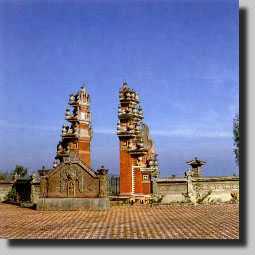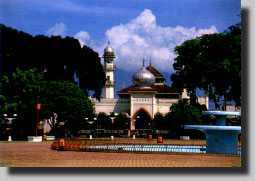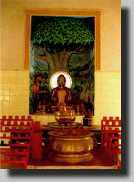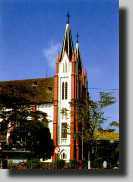
A
Hindu Temple, Wonokitri,
Mt Bromo
|

|
|
The
true homeland for the Javanese people is Central and East Java.
The western third of the island is dominated by another ethnic
group, the Sundanese, who have their own separate language and
customs. In East Java the population consists mainly of Javanese,
together with a sizeable number of settlers from the neighbouring
island of Madura. The Madurese, who form yet another distinct
ethnic and linguistic group, account for about 10% of the total
population of East Java. Aside from on Madura itself, they are
to be found chicfly along the north coast to the east of Surabaya,
as well as in the valleys between the volcanos.
There are also some 'lost tribes', such as the Osing people of
Banyuwangi and the native inhabitants of the Blambangan Peninsula,
who claim descent from long vanished kingdoms, rich in myth and
legend.Many of the cultural forms preserved by these distinct
communities are remnants of the great Hindu/Buddhist kingdom
of Majapahit, which for two hundred years was a major cultural
influence in southeast Asia until its collapse around the end
of the 15th century. |
Best known, perhaps, are the Tenggerese, who inhabit the mountainous
Bromo/Semeru region and trace their origins directly to Majapahit.
To this day they retain a Hindu/animist faith, not unlike that
found on the island of Bali. The Javanese have traditionally
tended to distinguish between two main complimentary, but sometimes
antagonistic, civilizing forces; one emanating from the island's
fertile heartland, the other bringing change from the sea. Port
towns like Tuban, Gresik and East Java's capital of Surabaya,
have for centuries been centres of trade, both material and intellectual.
The civilization which grew up in these towns was, therefore,
the result of a blending of cultures. Chinese, Indians, Arabs
and Europeans in turn contributed to the growth of these trade
centres, which at least once in the island's history became powerful
enough to defy their traditional rulers in the hinterland and
establish their own autonomous sultanates. Today, the historical
harbour towns of East Java are lively and colourful centres of
commerce and industry.
The province's commercial and administrative capital is Surabaya,
a thriving business and industrial centre as well as East Java's
main port. Second only to Jakarta in size and importance, the
city has a population of around 2.5 million residents. From the
port area of Tanjung Perak ferries leave regularly for Madura,
and air services to and from Surabaya's Juanda airport connect
the city with Jakarta, Yogyakarta, Bali and other parts of Indonesia.
The
Jamiq Mosque, Malang
 |
|
A
Chinese Klenteng , Madura
 |
|
A
European church, Malang
 |
|
South of Surabaya, in the
heart of East Java, is the city of Malang, second largest in the province.
Renowned for its cleanliness and refreshing atmosphere, Malang has a large
student population and is recognized above all as a centre of education.
Here, too, can be found many ancient historical sites dating back to the
13th century and earlier. Other prominent cities include Madiun,
Kediri and Banyuwangi.
East Java's predominant religion is Islam, which officially accounts
for 96% of the population, the rest embracing Hinduism, Buddhism,
Christianity (both Protestant and Catholic) and Confucianism.
These figures, however, can be misleading, since a large proportion
of Javanese continue to cling to traditional beliefs and customs,
known as kejawen, which are rooted in Hindu/Buddhist philosophy
and the reverence shown to ancestors. The result is a curious
blending of religious traditions, practiced sincerely and without
conflict in a spirit of tolerance. This is perhaps best witnessed
in the coastal cities, where the sacred graves of early Islamic
missionaries can be seen alongside European style churches and
colourful Chinese temples (klenteng). |
